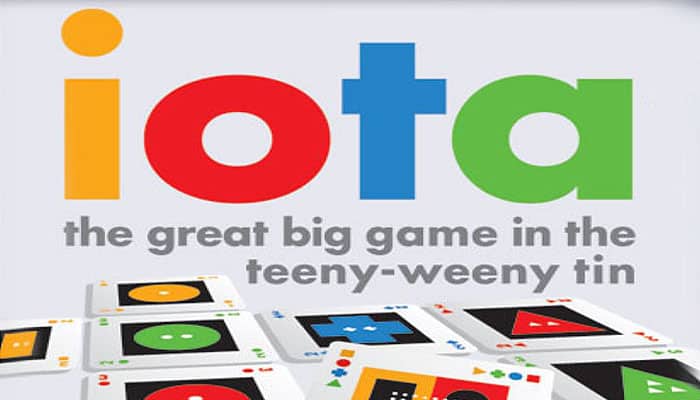

Components
- 64 different cards
- 2 Wild Cards plus instructions.
Object of the Game
To score the most points by adding cards in a line connected to cards already played.
A line consists of 2, 3 or 4 cards in a row in which each individual property (color, shape and number) is either the same on each card or different on each card.
Setup
You'll need a pencil and paper for scoring. Each player draws a random card. Highest face value goes first. Tied players redraw. Return cards, shuffle, and deal 4 cards face down to each player.
Remaining cards, face down, form the draw pile. Place its top card face up in the center of the playing area. That's the starter card. Players pick up and look only at their own cards.
Game Play
Players take turns adding cards to the grid established by the starter card. All cards played must connect to the grid and be played in the same line.
Although on any one turn cards must be played in the same line, additional lines may be created and/or extended as a result.
Cards needn't be in any particular sequence, nor do they need to be placed right next to each other. In other words, on one turn, a line can be created and/or extended by adding cards to both ends of it.
Maximum allowable line length is 4 cards. If there are any gaps, it's not a line... and some spaces on the grid will be impossible to fill. A 4 card line is called a lot. Creating one earns extra points.

On your turn:
Add 1,2,3 or 4 cards to the grid, in the same line, connecting to cards already played. As a result, additional lines may be created and/or extended. Then, replenish your hand to 4 cards...
or pass... and trade some, all or none of your cards back to the bottom of the draw pile and take new ones.
Play moves clockwise.
End of the Game
After each turn, add up the face values of all cards in each line either created or extended on that turn.
If a card is part of 2 lines, it is counted twice. Double points for the entire turn for each lot completed. Double again for playing all 4 of your cards on one turn.
The game ends when the deck has been depleted and one player plays his or her last card. Double points for that turn.
High score wins!
Easy as 1 2 3
Since any 2 cards have some or no properties in common, any 2 cards will work to begin a line. The 3rd and 4th cards in that line must satisfy the requirements set by the first 2 cards.
Therefore, before adding the 3rd card to a line, look at the 3 cards that would be in that line and ask yourself:
Are the colors either all the same or all different on each card?
Are the shapes either all the same or all different on each card?
Are the numbers either all the same or all different on each card?
If your answer to any of these is no, then it's not an allowable move.
Ask yourself these same questions before adding the 4th card to create a lot.
Examples
Examples of a Lot

Wild Cards

A Wild Card substitutes for any other card and has a face value of 0 points. It may be "recycled" prior to a player's turn by exchanging it for any other card allowable in that position. It may then be replayed on any turn.
While a Wild Card needn't represent a specific card, it must represent a single card. In other words, it's allowable for it to represent one card or another card, not one card and another card.
Play Example

Turn 1
2 cards are played. Same number, different colors, different shapes. 6 points.

Turn 2
2 cards are played creating a new 3 card line. Same shape, different colors, different numbers.
Cards must be played in a single line, though they needn't touch. 6 points.

Turn 3
2 cards are played. The yellow square 2 completes a lot. 2 new lines of 2 cards each are also created.
12 points for the 2 lines across (8+4). 5 points for the line up/down. Double for the lot. 34 points.

Turn 4
4 cards are played completing 2 lots. Face value of each lot is 10 points. A second line down worth 6 points is also extended for a total of 26.
Double all points for lot 1. Double again for lot 2, and double again for playing all 4 cards. 208 points.
Continue Reading

